Pistol Iron Sights: Ultimate Guide to Accurate Shooting
 Bryan Hill / October 01 2024
Bryan Hill / October 01 2024
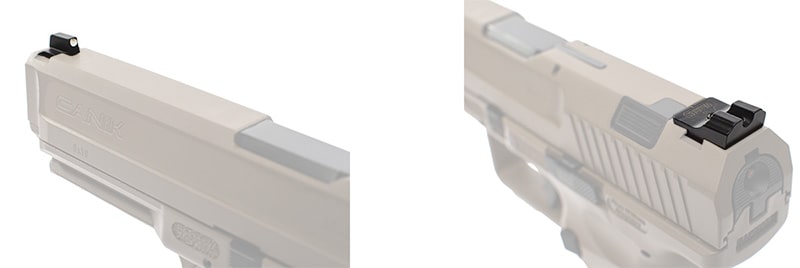
If you want to shoot a pistol accurately, you need to use the sights.
We'll cover how pistol iron sights work, how sight radius works, which types of pistol iron sights are best,
other common questions about pistol iron sights, and what to do if you just can't use pistol iron sights.
On This Page:
- Basics
- Why do Good Sights Matter on a Pistol?
- Which Pistol Sights are Best?
- What are Night Sights?
- Sight Radius
- Are Pistol Sights Adjustable?
- Which Loctite for Pistol Sights?
- Where to Have Pistol Sights Installed?
- I Can't See Pistol Sights. What do?
- References
Basics
Sights sit on top of the
slide.
They are critical to accurate shooting.
Sights are made of two parts:
-
A front sight. By itself, it just gives a ballpark of where the gun is pointed.
Side View:
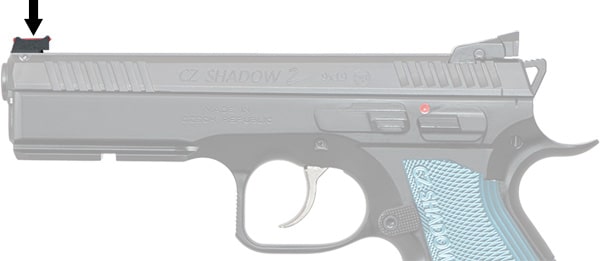
Rear View:

-
The rear sight has a window to view the front sight.
Side View:
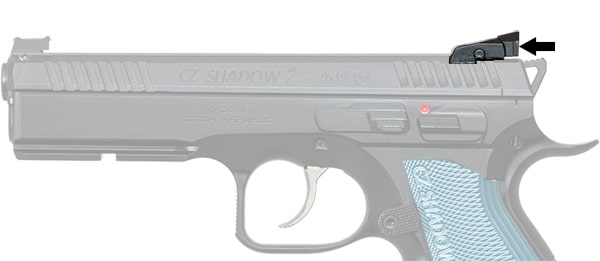
Rear View:

Using both sights together allows for precise shooting.
Why do Good Sights Matter on a Pistol?
They give more accurate aim, faster.
A case study by a USPSA Grandmaster Karl Rehn found that upgrading stock Glock sights improved shooting accuracy/speed 7%.
Which Pistol Sights are Best?
When shopping for iron sights, it's hard to go wrong with
Dawson Precision .
Keep these points in mind when shopping:
-
Front sight is bright, so you can see it, aim, and shoot faster.

A fiber optic, or tritium insert + fiber optic gets the job done.
If it's too bright, use a non-permanent marker on the top of the fiber optic to dim it.
-
Rear sight is dark, so you don't confuse it with the front sight.
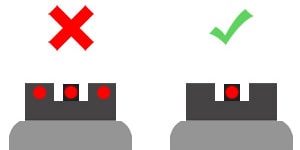
Some top shooters use fiber optics in the rear sight, but try a blacked out rear first and see if it works for you.
-
Near shooting (10 yds. or less): Front sight is wide (0.140" or wider), so you can see it faster.
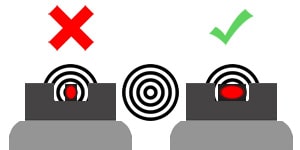
-
Far shooting (over 10 yds.): Front sight is narrow (0.100 - 0.125"), better see far targets.

A standard (0.140") fat front sight covers about:
-
2" at 10 yds
-
3" at 15 yds
-
5" at 25 yds
-
10" at 50 yds
A 0.100" front sight covers about 71% of what a 0.140" would.
That's 3.6" at 25 yds and 7.1" at 50 yds.
-
Rear sight window is wide, for more precision and to see the front sight faster.
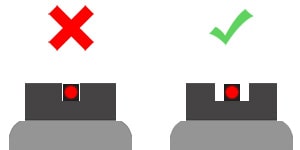
The window should be 0.30 - 0.40" wider than a narrow (0.100 - 0.125") front sight
and 0.50 - 0.65" wider than a fat (0.140") front sight.
-
Rear sight window is deep (0.140" or more), to make the sights
easier to read when they're not perfectly aligned (like in recoil).
-
Top of the front and rear sights are serrated, so they don't glare in bright light.
What are Night Sights?
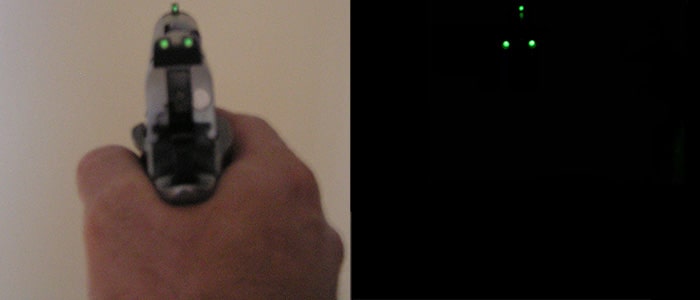
Night sights have glow-in-the-dark inserts so you can see them better in low light.
They sound great, right? Problem is,
they're only useful for about 20 minutes after sunset or before sunrise.
Why? In all other conditions:
-
It's so bright that you don't need night sights.
-
It's so dark that you can't ID your target.
Save the $100+ you'd spend on night sights and put it towards a
flashlight and
weapon light instead.
Unlike night sights, they can ID (or even blind) targets, and are useful no matter how dark it is.
Sight Radius
Sight radius is the distance between the front and rear sights.
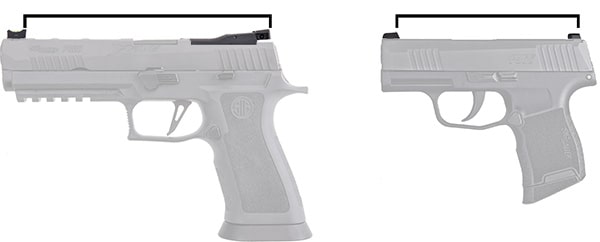
It only matters for far shooting (over 10 yds.).
A short sight radius makes longer shots tougher, but it's not everything. Take this guy shooting a 12" plate at 177 meters:
The sight radius on that pistol is as small as it gets, but it didn't stop him.
A larger sight radius helps, but your skill in trigger control and sight alignment is what matters most.
Are Pistol Sights Adjustable?
It depends.
If you see big screws on a rear sight, they can be adjusted left/right and sometimes up/down:

Otherwise, some front and rear sights can be adjusted left or right, but not all. It depends on the pistol.
Which Loctite for Pistol Sights?
Dovetail Front Sights: Loctite Red 262
Why? It's resistant to gun cleaners, and it's temperature-resistant. The front sight heats up as you shoot a pistol.
Rear Sights and Screw-On Front Sights: Loctite Blue 242
Why? It's strong, but has enough give for adjusting a rear sight left/right if needed. Use a tiny bit on set screws so they can be loosened if needed.
Where to Have Pistol Sights Installed?
Check with your local gunsmith:
I Can't See Pistol Sights. What do?
Need pistol sights for old eyes, astigmatism, etc.? The right choice depends on your pistol:
References
-
How Spatial Frequencies and Color Drive Object Search in Real-world Scenes: A New Eye-movement Corpus (2020)
-
Luminance Information Is Required for the Accurate Estimation of Contrast in Rapidly Changing Visual Contexts (2020)
-
Do Aftermarket Mods Help You Shoot Better? (2019)
-
Effects of absolute luminance and luminance contrast on visual discrimination in low mesopic environments (2016)
-
Loctite Adhesive (2016)
-
Fiber optic vs. black rear sights why? (2015)
-
The Attentional Effects of Single Cues and Color Singletonson Visual Sensitivity (2013)
-
Luminance contrast and the visual span during visual target localization (2013)
-
.22 Pistol LONG RANGE SHOOTING - Rex Reviews (2012)
-
Time to share some Iron Sight discoveries (2011)
-
Enos' Ideal Front Sight Width (2009)
-
Crowding degrades saccadic search performance (2006)
-
Basic Vision: An Introduction to Visual Perception (2006)
-
Integrating neuronal coding into cognitive models: Predicting reaction time distributions (2005)
-
Handbook of Psychology, Experimental Psychology (Ch. 4) (2003)
-
Effect of stimulus contrast on performance and eye movements in visual search (2001)
-
Response Times And Eye Movements in Feature And Conjunction Search as a Function of Target Eccentricity (1998)
-
FACTORS UNDERLYING VISUAL SEARCH PERFORMANCE (1969)